Impactful student enrollment management calls for the regular adoption of new strategies that meet the ever-changing expectations of your prospective students.
More than ever, students expect the ability to learn about their potential schools through virtual means, such as social media, a school website, even online tours.
This article describes numerous online tactics for effective enrollment management, from using inbound marketing to taking advantage of admissions software.
Let’s dive in.
- Begin With a SWOT Analysis
- Show Off Your School Through Events
- Use Inbound Marketing for Your School
- Involve Your School’s Alumni Network
- Take Advantage of School Admissions Software
- Conclusion
Begin With a SWOT Analysis
A SWOT analysis is a strategic planning activity that reveals your school’s strengths, weaknesses, opportunities, and threats.
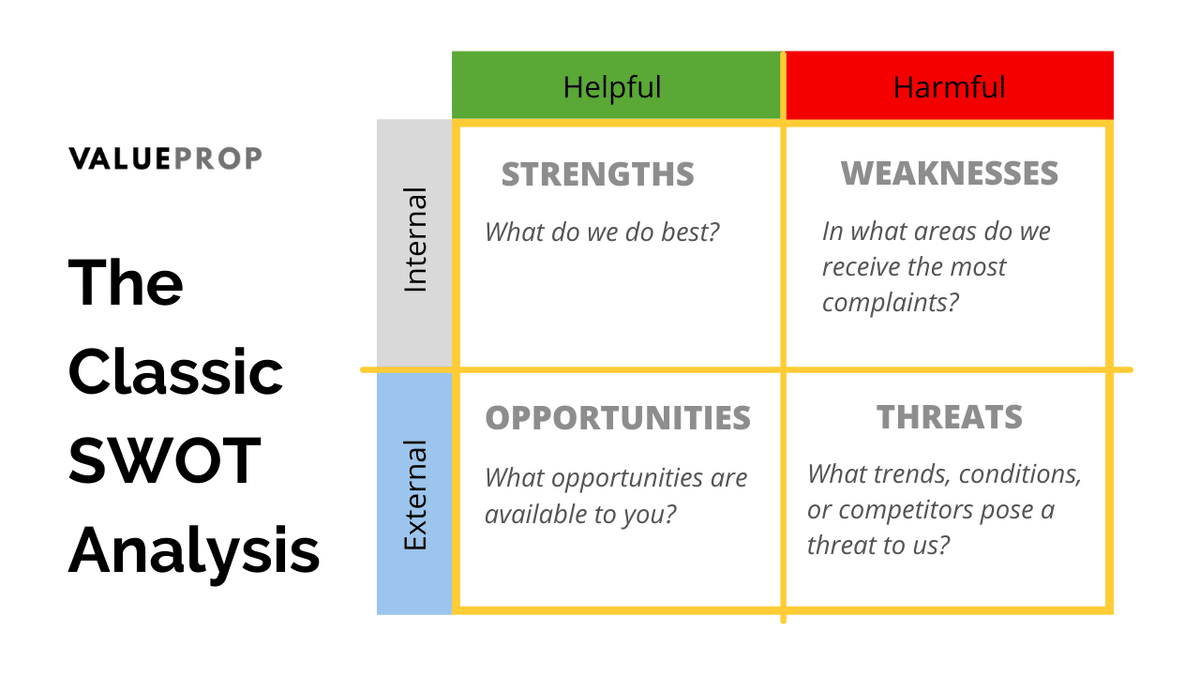
Source: Value Prop
Knowing where your school currently stands will help you come up with the most impactful strategies for improving school enrollment. You’ll know where to put your time and money.
For example, if one of your current weaknesses is retaining engineering students, then you can focus your resources on giving them the support they need to finish and graduate.
Or, you might find that there’s a shift toward online learning, and note that your competitors are lagging behind in this area.
As long as you have the resources and technical know-how, that’s an opportunity your team can seize to stand out from the competition.
When you do your SWOT analysis, bring as much relevant data and market research to the table as possible, as this will help you form an accurate picture of your school.
It’s also best to do your analysis as a group, involving the key members of your enrollment team.
This will help you draw from everyone’s knowledge about your market, school, and current enrollment strategies.
Consider using a SWOT analysis template like the one below from SmartSheet:

Source: Smartsheet
That way, you can store the information online so that your team can access it when they’re trying to figure out what venture to tackle next.
Or you could use a template that prompts you with actual questions and helps you brainstorm more efficiently, like this one from WordStream:
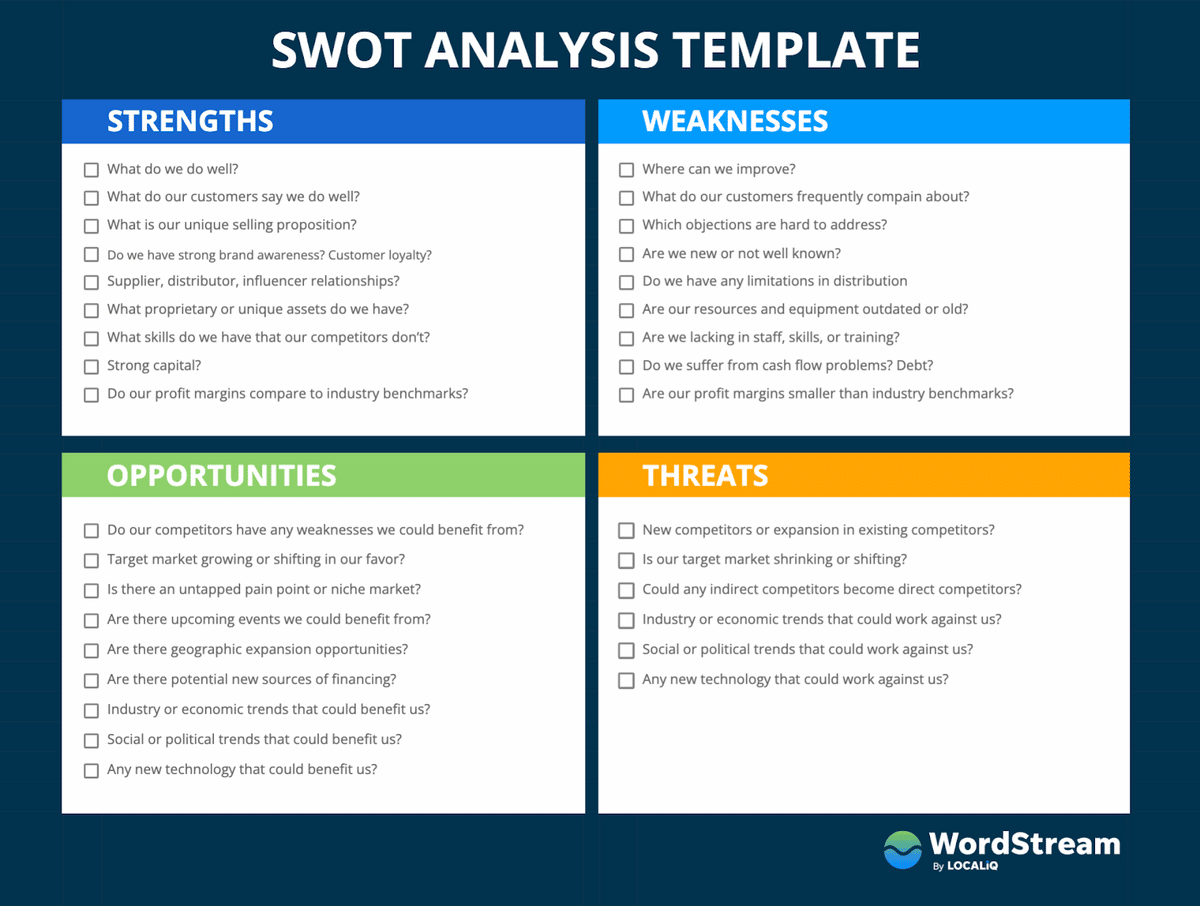
Source: WordStream
Looking at pre-crafted questions like “Are target markets shifting in your favor?” or “What do our customers say we do well?” will guide your analysis in the right direction.
If you don’t know the answers to these questions, be sure to go out and find them, either through research or outreach.
For example, if you aren’t sure what your students say you do well, you could create a survey and send it out via email.
This will help you get real feedback about your school’s strengths, which you can then highlight in your marketing material.
In sum, conducting a SWOT analysis is a great way to gain visibility into your school’s current situation and identify effective ways to improve student enrollment.
Show Off Your School Through Events
Visiting a school and walking its grounds can have a magical effect on potential students.
Something as simple as the sight of a cozy reading tree or a well-decorated classroom can make a prospective student want to apply and attend your school.
Therefore, it’s important that your school provides these opportunities for prospective students, and their parents, to spend some time at your school.
Here are some great event ideas to host at your school:
| Prospective students day | Give interested students and parents a tour of the school and hold informational lectures from faculty and staff. |
| Concert | Inviting popular performers is a great way to satisfy current students while also attracting potential ones to your school grounds. |
| Accepted students day | Convince accepted students to attend by providing them with tours and lectures about school life and their chosen programs. |
| Talent show | Have your current students show off their best talents and invite people from your area to attend. |
To kill two birds with one stone, you could host a school fundraiser event that prospective students and parents in your community will want to attend, such as a walk-a-thon or a raffle.
It’s also important to host virtual events because they allow you to reach prospective students who wouldn’t have been able to travel to visit your school.
Webinars are a great option. In them, you can discuss your school’s different programs, campus life, dining facilities, after-school programs, financial aid, admissions, or anything else your prospective students would want to know about.
Here are a few webinars from the University of California:
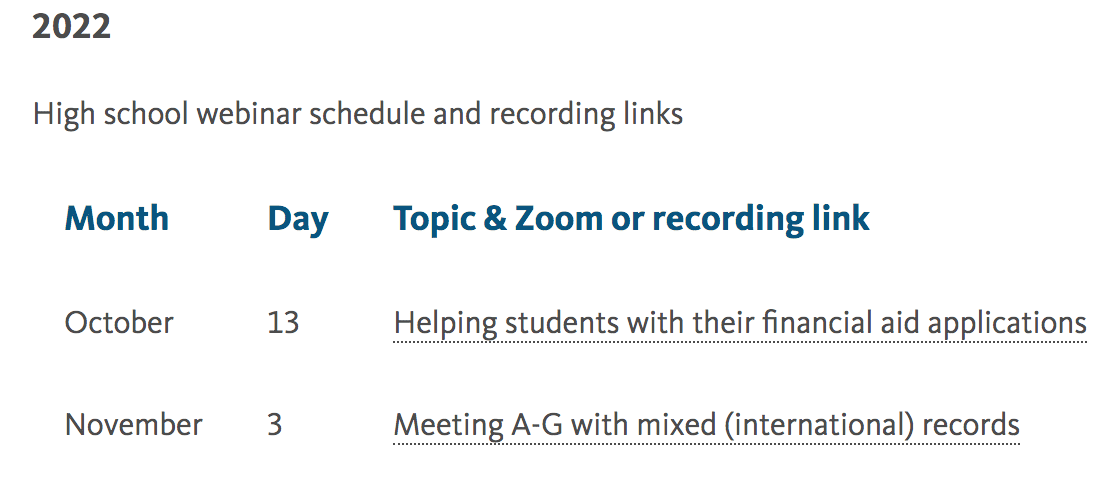
Source: University of California Admissions
Financial aid webinars are often effective for improving enrollment because there are typically a large number of students who shy away from the application process because they don’t believe they can pay.
This gives you a chance to show them it’s possible.
The nice thing about webinars is that you can record them and keep them up on your website so that people who weren’t able to attend the live event can still access the content.
Speaking of digitizing experiences and making them accessible, schools can also create online tours of their schools with virtual touring software.
Here’s an example of a virtual tour from Yale:
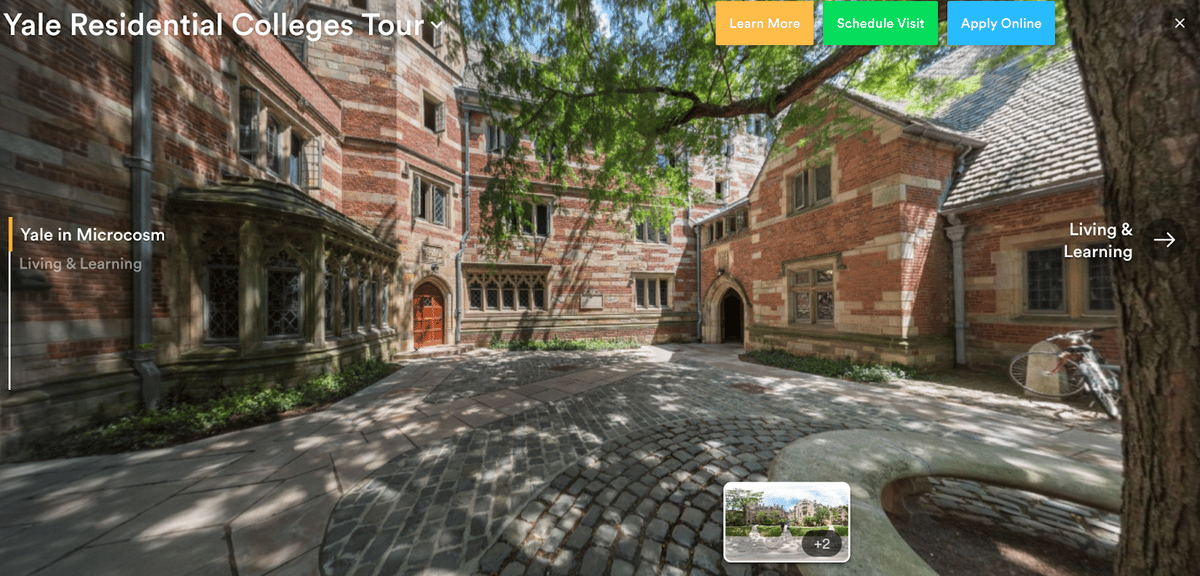
Source: Yale Admissions
It contains an audio component as well. A current student talks to you as you walk through the virtual campus, providing commentary on each place you visit.
Aside from hosting in-person and online events, there are other ways to meet potential students.
Consider also attending events like college fairs held at high schools consisting of students in your target market.
What matters most for your student enrollment is that you regularly get into conversations with potential students and parents and educate them about your school’s value.
Use Inbound Marketing for Your School
Inbound marketing is the process of creating online content, like blog posts or social media posts, that capture the attention of prospective students and parents and make them interact with your school’s brand.
Preferably, any content you create should help the students in some way, typically by providing some kind of information they need.
For example, a helpful video on YouTube detailing your school’s admissions process and financial aid options should encourage them to apply.
But the content doesn’t have to be directly related to applying to your specific school. It can also answer questions they have about their next steps in education in general.
For example, a small liberal arts college might create a blog post answering the question “What jobs can liberal arts majors get?”
At the end of the article, the school could ask readers to head to the college’s admissions page to learn more about the benefits.
If it’s well written, the article could rank high on Google’s results pages and be read by a bunch of students who are asking this question.
Many will read it, appreciate the help, then decide to check out the school’s offerings.
This is exactly what Michigan Tech does for the query “How hard is it to get into med school?”:
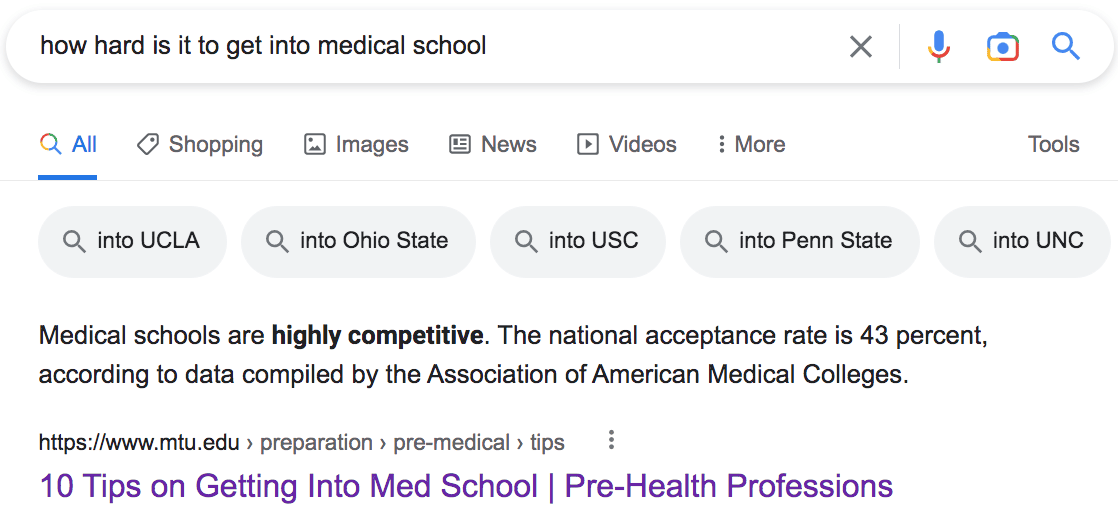
Source: MTU
They’re able to rank number one on a competitive query and attract a lot of pre-med students to their website.
At the end of their article, they plug their program and state that their school’s med school placement rate is 60-70%, much higher than the national average.
They then link out to their pre-med programs page, where readers can learn more.

Source: MTU
In addition to blogs and social media posts, you can also use paid methods like placing online ads on websites that get a lot of views from people who fit your target market.
In sum, creating online resources that drive traffic to your school’s website is a great way to increase enrollment and also, especially in the case of social media, build stronger relationships with current students.
Involve Your School’s Alumni Network
Another effective student enrollment strategy is to involve your alumni network in some promotional activities.
Prospective students will love to hear about the experiences former students had while attending your school.
Consider interviewing some alumni and asking them questions like “What did you love about our school?” or “How did your education here set you up for career success?”
Then take those answers and turn them into success story content that you can share on your social media profiles and website.
Or turn the entire transcript of the interview into a blog post, as Columbia has done below:
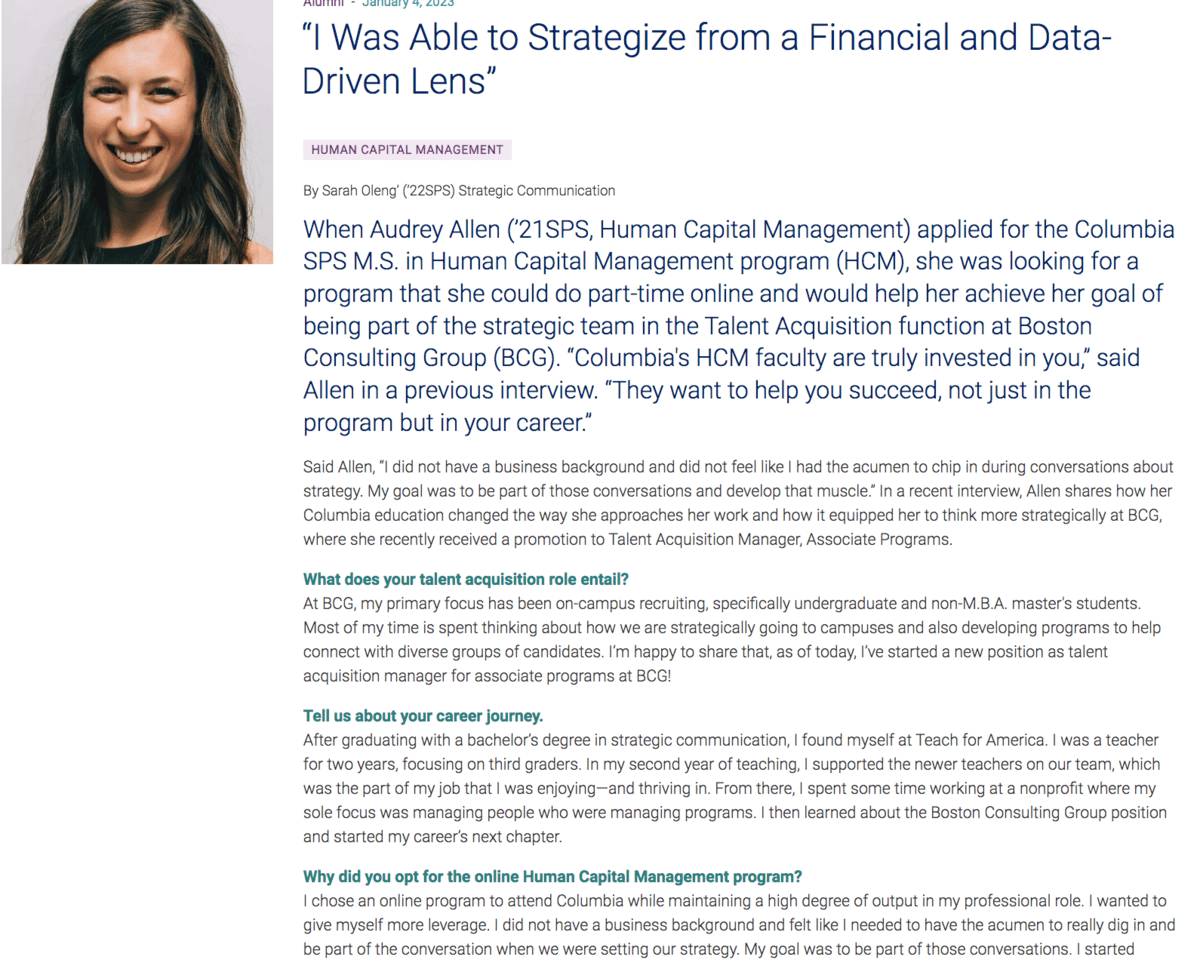
Source: Columbia
And then get the eyes of those prospective students on that blog post by promoting it across various social media channels.
You can take this approach a step further by filming your interviews with your alumni.
This gives potential students the opportunity to hear it straight from the former attendee, which can be a more impactful experience.
A second way to get alumni involved in student recruitment efforts is to partner with them and turn them into influencers.
In this strategy, you’ll ask alumni who are active on social media platforms and have preferably large social followings to share content about your school across social channels, primarily Tik Tok, Instagram, and Snapchat—where high schoolers are most active.
Many of the alumni will be more than happy to help and promote your school, especially if they got great value from their time there.
However, to make the deal sound more beneficial to your alumni, remind them that they’ll be developing their network through this process.
And a larger network is a great thing for their careers, especially when it contains students (future potential employees and peers) who are pursuing similar career goals as them.
Another plus of using alumni is that their enthusiasm for your school is bound to rub off on prospective students.
In sum, working with alumni by asking them to promote your school on social media and participating in interviews that you can draw from to make promotional content.
Take Advantage of School Admissions Software
Adopting school admissions software is a quick way to increase efficiency and free up time for your team so they can focus on recruitment initiatives that make use of their people skills and specialized knowledge, like coordinating with alumni or planning a recruiting event.
Admissions software typically offers features that help you streamline your team’s responsibilities across lead management, lead nurturing, application management, and final enrollments.
It also usually includes some sort of online registration and payment functionality, so prospective students can easily sign up via their laptops and mobile devices.
For example, many tools, such as Regpack, give you the ability to easily create online registration forms that you can then host on your website:
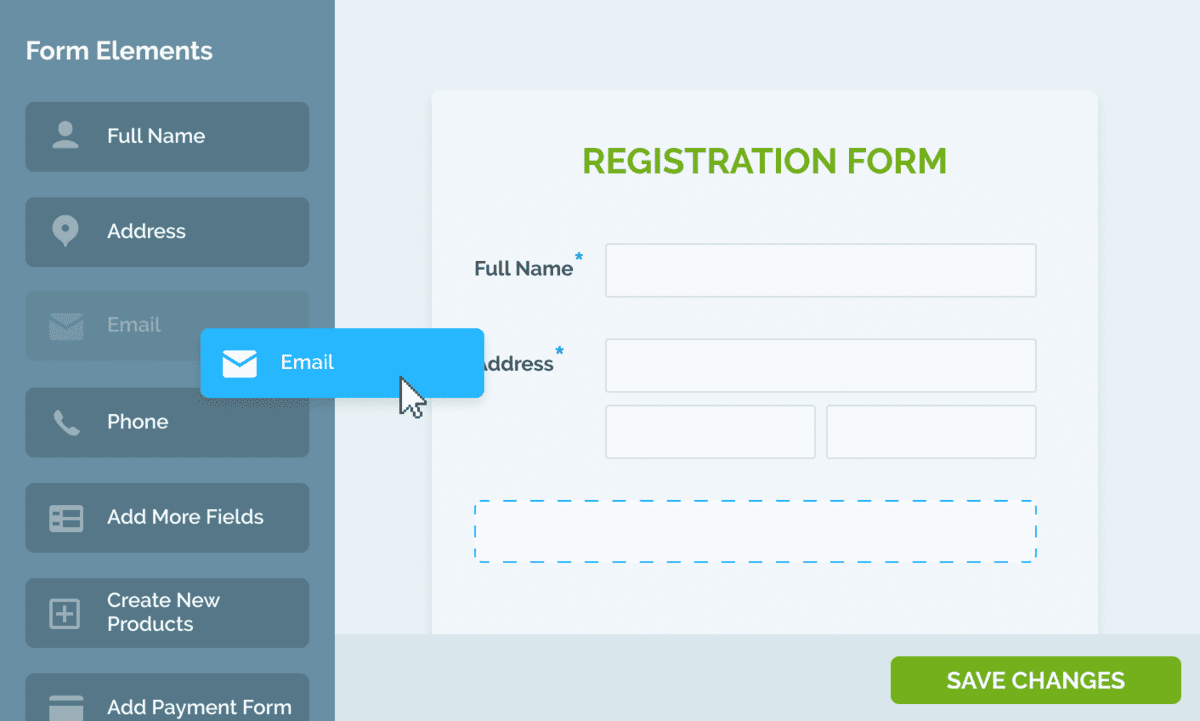
Source: Regpack
With the drag-and-drop editor, numerous fields to choose from, and branding tools, you can quickly create custom forms that will increase registrations to admissions events and your school’s programs.
These tools also come with email communication features that help you manage and automate your email marketing to prospective students.
For example, in Regpack you can make it so that emails automatically get sent to students if a certain trigger event occurs:
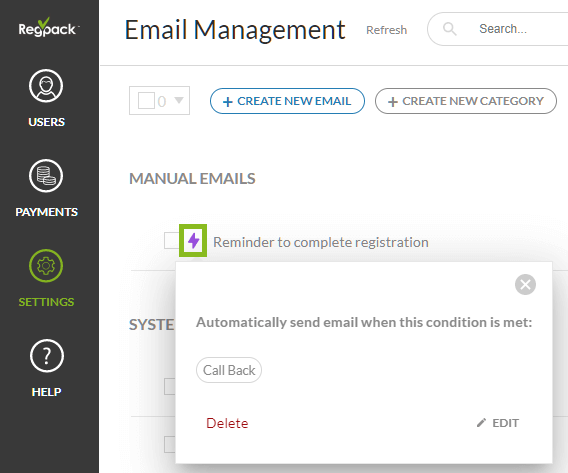
Source: Regpack
You can also create email templates with smart fields that automatically populate with relevant information like the student’s name, high school, and other data you have saved in the software.
That way, potential students you’re courting get a personalized experience.
Admissions software also comes with reporting functionality that empowers you to gain further insight into the effectiveness of your recruiting strategies.
For example, you can do things like figure out whether or not your recent school event resulted in an uptick in registrations.
In sum, admissions software will streamline the repetitive enrollment management activities and enable you to focus your energy on the more impactful parts of the job.
Conclusion
If you can master student enrollment management, you’re going to have an easy time consistently improving your school’s retention and recruitment rates.
Some smart methods for improvement in this area are running a SWOT analysis, hosting events, using inbound marketing, and implementing school admissions software.
If you want to learn more about how to attract students to your school, check out our article 9 practical tips for increasing student enrollment, where we cover strategies like hosting after-school programs and building a strong school website.


















